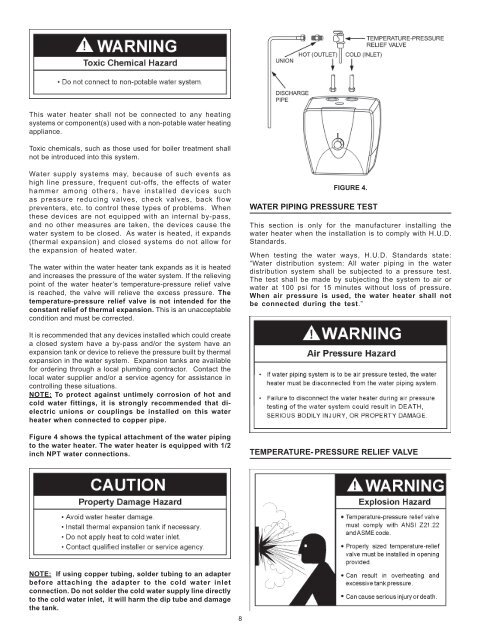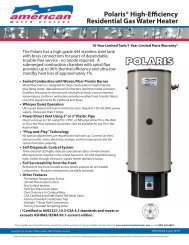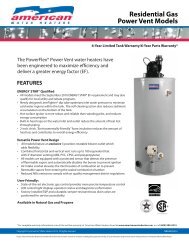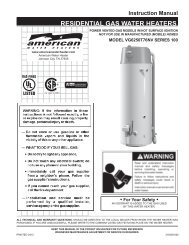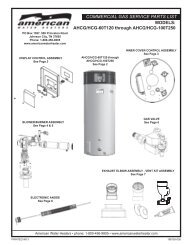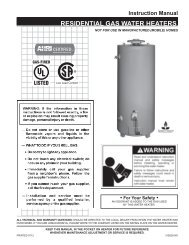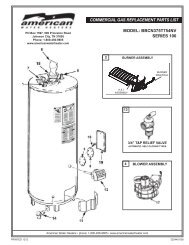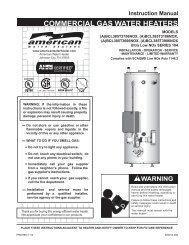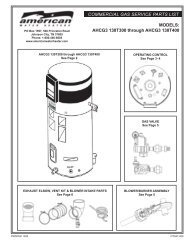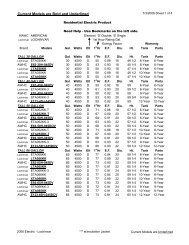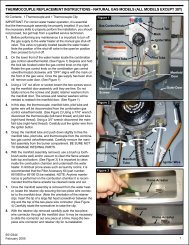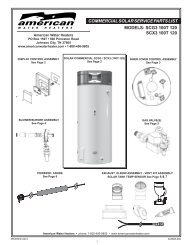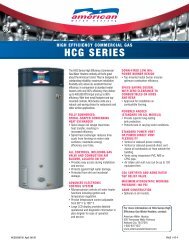instruction manual residential electric 2.5 Gallon 120 volt water heater
instruction manual residential electric 2.5 Gallon 120 volt water heater
instruction manual residential electric 2.5 Gallon 120 volt water heater
You also want an ePaper? Increase the reach of your titles
YUMPU automatically turns print PDFs into web optimized ePapers that Google loves.
This <strong>water</strong> <strong>heater</strong> shall not be connected to any heating<br />
systems or component(s) used with a non-potable <strong>water</strong> heating<br />
appliance.<br />
Toxic chemicals, such as those used for boiler treatment shall<br />
not be introduced into this system.<br />
Water supply systems may, because of such events as<br />
high line pressure, frequent cut-offs, the effects of <strong>water</strong><br />
hammer among others, have installed devices such<br />
as pressure reducing valves, check valves, back flow<br />
preventers, etc. to control these types of problems. When<br />
these devices are not equipped with an internal by-pass,<br />
and no other measures are taken, the devices cause the<br />
<strong>water</strong> system to be closed. As <strong>water</strong> is heated, it expands<br />
(thermal expansion) and closed systems do not allow for<br />
the expansion of heated <strong>water</strong>.<br />
The <strong>water</strong> within the <strong>water</strong> <strong>heater</strong> tank expands as it is heated<br />
and increases the pressure of the <strong>water</strong> system. If the relieving<br />
point of the <strong>water</strong> <strong>heater</strong>’s temperature-pressure relief valve<br />
is reached, the valve will relieve the excess pressure. The<br />
temperature-pressure relief valve is not intended for the<br />
constant relief of thermal expansion. This is an unacceptable<br />
condition and must be corrected.<br />
FIGURE 4.<br />
WATER PIPING PRESSURE TEST<br />
This section is only for the manufacturer installing the<br />
<strong>water</strong> <strong>heater</strong> when the installation is to comply with H.U.D.<br />
Standards.<br />
When testing the <strong>water</strong> ways, H.U.D. Standards state:<br />
“Water distribution system: All <strong>water</strong> piping in the <strong>water</strong><br />
distribution system shall be subjected to a pressure test.<br />
The test shall be made by subjecting the system to air or<br />
<strong>water</strong> at 100 psi for 15 minutes without loss of pressure.<br />
When air pressure is used, the <strong>water</strong> <strong>heater</strong> shall not<br />
be connected during the test.”<br />
It is recommended that any devices installed which could create<br />
a closed system have a by-pass and/or the system have an<br />
expansion tank or device to relieve the pressure built by thermal<br />
expansion in the <strong>water</strong> system. Expansion tanks are available<br />
for ordering through a local plumbing contractor. Contact the<br />
local <strong>water</strong> supplier and/or a service agency for assistance in<br />
controlling these situations.<br />
note: To protect against untimely corrosion of hot and<br />
cold <strong>water</strong> fittings, it is strongly recommended that di<strong>electric</strong><br />
unions or couplings be installed on this <strong>water</strong><br />
<strong>heater</strong> when connected to copper pipe.<br />
Figure 4 shows the typical attachment of the <strong>water</strong> piping<br />
to the <strong>water</strong> <strong>heater</strong>. The <strong>water</strong> <strong>heater</strong> is equipped with 1/2<br />
inch NPT <strong>water</strong> connections.<br />
Temperature- Pressure Relief Valve<br />
NOTE: If using copper tubing, solder tubing to an adapter<br />
before attaching the adapter to the cold <strong>water</strong> inlet<br />
connection. Do not solder the cold <strong>water</strong> supply line directly<br />
to the cold <strong>water</strong> inlet, it will harm the dip tube and damage<br />
the tank.


